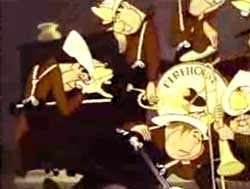 The Firehouse Five Plus Two was led by Ward Kimball, a famous animator for Disney. His bad was made up of other Disney animators.
The Firehouse Five Plus Two was led by Ward Kimball, a famous animator for Disney. His bad was made up of other Disney animators.
They specialized in Dixieland & given the environment of their creativity, they were unusually strong in the "fun" department. But more than being joyful, they were legitimately a very fine Dixieland band.
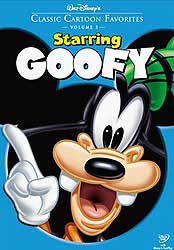 They performed regularly at Disneyland, on The Mickey Mouse Club television show of the 1950s, & they did the music for numerous Disney films & a huge number of cartoons. They performed regularly at Disneyland, on The Mickey Mouse Club television show of the 1950s, & they did the music for numerous Disney films & a huge number of cartoons.
In How to Dance (1953), Goofy the human-like dog gets himself a tuxedo, some dance lessons, & takes to the dance hall hoping to show off his new skills.
The band members who first appear sleeping at their instruments are caricatures the actual Firehouse Five Plus Two, who naturally enough did the soundtrack. You can even read the band's name on the drum head.
The joke, which completely stops Goofy from being able to use anything he has learned, is that the music is way too fast because entirely Dixieland. A crowd of much more skillful dancers shove & batter him about the dance floor, oblivious to his agonies.
How to Dance is includced in the dvd compilation Classic Cartoon Favorites Volume 3: Starring Goofy (2005) which contains eight other Goofy cartoons as well.
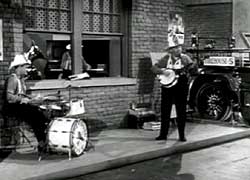 How in the world the Firehouse Five Plus Two managed to keep full time animators' jobs & still perform at the Disneyland park & make records & personal appearances throughout the United States is beyond me, but they managed to keep up the pace for about twenty years.
How in the world the Firehouse Five Plus Two managed to keep full time animators' jobs & still perform at the Disneyland park & make records & personal appearances throughout the United States is beyond me, but they managed to keep up the pace for about twenty years.
They were guest performers on all the great variety shows of '50s television, such as the Ed Sullivan's show, Milton Berle's show, Ed Wynn's show, Stars of Jazz, & many others before even considering the numerous Disney television projects they spiced up.
In 1951 they made a half-dozen three-minute live-performance films for Lou Snader's small company. These films are known as "Snader Telescriptions." The intent was to provide "records" with live video included that could be played by television disc jockeys, for in the very early '50s radio provided as many inspirations as did cinema for what broadcast television was going to be like.
It was all too soon obvious that three-minute pop tunes weren't going to provide a common format for television. Fifteen minute to one-hour variety shows would be the place for music, without need of a disc jockey spinning video telescriptions. The films had some distribution as use for filler material when not enough advertising was sold.
By 1954 Snader was bought out by Studio Telescriptions & some of the short films were being lumped together as fake concerts. As many of the Snaders were done of unadorned stages it was easy to pretend each act in turn was actually playing in one place on the same day.
But other Snaders had elaborate sets -- the Firehouse Five Plus Two filmed theirs on a stage decked out to look like a brick firehouse -- & such as these frequently languished unseen, until the home-video era began & such material began surfacing.
As authentic live performances well-recorded & expertly filmed, these telescriptions are wonderful filmic documents of great musical performances. Hook & Ladder Blues (1951) shows the band as always in full fireman drag. The set looks like a real vintage firehouse but with upright piano & other musical instruments handy.
Our happy firemen wander about the station arriving at their instruments & begin the poky-beat dixieland blues instrumental.
It's highlighted by a lively clarinet solo & a whimsical tuba solo, then some hard strumming on a banjo serving as banjo solo before the cornet brings it on home. It's about as much fun as the blues gets.
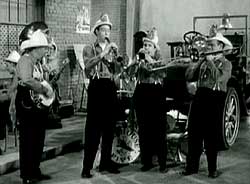 The models for these short films were the soundies of the first half of the 1940s. But those had their music pre-recorded usually the day before the visual shoot, whereas the Snaders are honest to gosh live performances.
The models for these short films were the soundies of the first half of the 1940s. But those had their music pre-recorded usually the day before the visual shoot, whereas the Snaders are honest to gosh live performances.
The soundies, however, were sometimes quite elaborately staged like scenes from movies, whereas the Snaders were much more streamlined in order to get one-take performance-films with two or three cameras going for the sake of cuts & close-ups, then it would be a quick move to the next mini-film.
This meant some performers had no particular set at all, just a stage performance. And if like the Firehouse Five Plus Two they did have an elaborate set, it would be used over & over again.
So same firehouse set was to be used for several Snaders. Brass Bell (1951) opens with a close-up of a vintage fire engine, then pan to the trumbonist who is Ward Kimball himself, & the number is instantly in full sway.
There'll be an especially delightful piano solo for Frank Thomas in the arrangement, & several other members of the band also highlighted: mute cornet solo Danny Alguire, clarinet solo by Clarke Mallor, banjo solo by chubby Harper Goff. And drummer Monte Mountjoy gets to play around with a firebell.
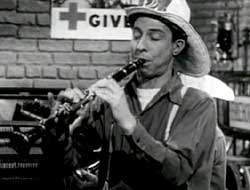 The Firehouse Five Plus Two performs Everybody Loves My Baby (1951) with a powerful dixieland beat. In keeping with their usual presentation, the band is still decked out in firemen costumes, arrayed with their instruments around the firetruck on the familiar brick-wall fire station set.
The Firehouse Five Plus Two performs Everybody Loves My Baby (1951) with a powerful dixieland beat. In keeping with their usual presentation, the band is still decked out in firemen costumes, arrayed with their instruments around the firetruck on the familiar brick-wall fire station set.
Clarke Mallory gets the lion's share of solo on his licorice clarinet, with Harper Goff's banjo as much a percussion instrument as Monte Mountjoy on the actual drums. The cuteness of the performances by this group never outweighs the excellence of their musicianship.
There's some surprising camera work that pans along the group to the beat, & the clarity of these old films is excellent, the sound pretty darned good.
As the guys finish off their number, they quickly set aside their instruments, divide up a newspaper, & sit on the floor to read the various sections.
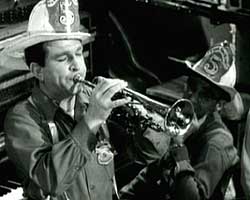 The drummer begins the beat then the cornet plays an intentionally workmanlike & ordinary rendition of "Red River Valley." But this is about to turn into Red Hot River Valley (1951), a witty Dixieland arrangement of the classic country folksong.
The drummer begins the beat then the cornet plays an intentionally workmanlike & ordinary rendition of "Red River Valley." But this is about to turn into Red Hot River Valley (1951), a witty Dixieland arrangement of the classic country folksong.
Nice banjo solo is the highlight. The Firehouse Five Plus Two were instrumentalists almost exclusively & didn't sing, but this one's close to including vocalis, as banjoist Harper Goff begins a campy & fun whistling solo & the rest of the guys harmonize in the background. This is a happy routine for kids that'll also delight the grown-ups.
There's a follow-up piano solo, & even a glimpse of Frank Thomas's face, though in most of these Snaders he's the only guy with his back to the camera so we don't see much of his face.
A clarinet solo comes up next then as the number ends. A flag is brought out with the band's name thereon, & the guys stand silently mugging at the camera & pointing at their flag.
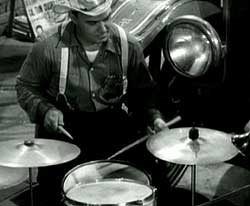 Despite a copyright date on the title card for the Snader telescription South (1952) which is a year later than the previous Snaders, chances are these were all filmed at the same time but released for television airplay in a staggered manner, as it's the familiar set with even the same posters on the walls.
Despite a copyright date on the title card for the Snader telescription South (1952) which is a year later than the previous Snaders, chances are these were all filmed at the same time but released for television airplay in a staggered manner, as it's the familiar set with even the same posters on the walls.
It's a jolly bouncy number with a whimsical slide trumbone lead from Kimball himself, our chubby banjoist hopping about as a piano solo takes over, then mute cornet, then a very happy seeming clarinetist gets the limelight. There's even a bit of a drum solo on this one.
The Firehouse Five Plus Two like to end their telescriptions with some minor routine like sharing that newpaper in Everybody Loves My Baby, bringing out the flag in Red Hot River Valley, or leaping on the engine in Firehouse Stomp (1951).
These small closing touches were quite natural for a group of guys who were usually drawing gags for Disney cartoons. For South they merely all point together at their name on the drumhead.
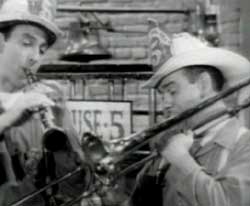 With the firebell clanging & the cornet starting off the number with an imitation of a fire engine siren, Firehouse Stomp (1951) sounds momentarily like a John Phillips Souza patriotic march tune until the banjo takes over.
With the firebell clanging & the cornet starting off the number with an imitation of a fire engine siren, Firehouse Stomp (1951) sounds momentarily like a John Phillips Souza patriotic march tune until the banjo takes over.
When everyone is going full blast, it's definitely parade music, & probably the least of these otherwise fine Snader performances. As it ends, everyone jumps on the vintage fire engine clanging on the bell.
All six of the Snaders done by the Firehouse Five Plus Two are included on the compilation Swing Era: Firehouse Five Plus Two, Red Nichols & His Five Pennies, Pete Daily & His Chicagoans (2003).
This has also been released as Dixieland Jazz Volume 2: Firehouse Five Plus Two, Red Nichols & His Five Pennies, Pete Daily & His Chicagoans (2002) & as Meet the Dixieland Bands Volume 2 (1985). The same selection will doubtless have other titles as it goes through future re-releases.
For the other Dixielanders included in the same dvd compilation, see the review pages for Pete Daily telescription films & Red Nichols vitograph shorts & telescriptions. Also, for reviews of dixieland telescriptions from Meet the Dixieland Bands Volume 1 (1985), see The Bobcats' telescriptions & Jack Teagarden & His All Stars.
copyright © by Paghat the Ratgirl
|
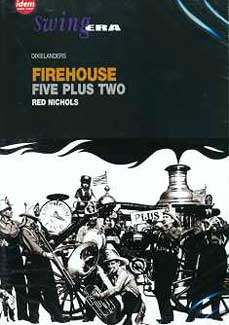

 They performed regularly at Disneyland, on The Mickey Mouse Club television show of the 1950s, & they did the music for numerous Disney films & a huge number of cartoons.
They performed regularly at Disneyland, on The Mickey Mouse Club television show of the 1950s, & they did the music for numerous Disney films & a huge number of cartoons.




